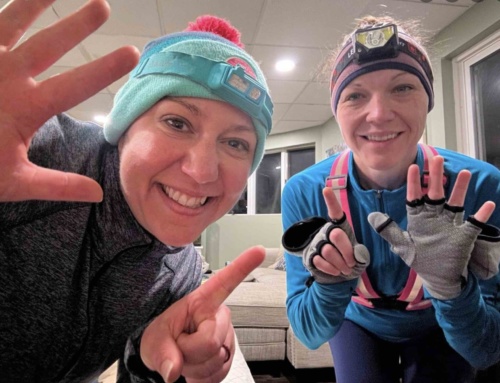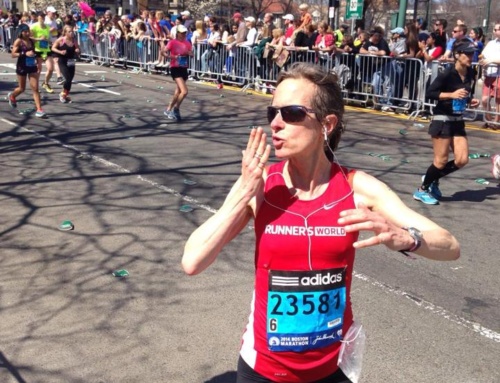Amy Johns, all smiles as she dons her Mystic Half-Marathon medal.
Note: This is our second in our 2018 Goals Series. Missed the first post about Bethany, a divorced, ambitious #motherrunner? Grab it.
Aren’t you so happy you ran today?
(If you didn’t run today, no worries. Get back to us when you do.)
You run because it makes you feel better—physically, mentally, emotionally.
You don’t need a degree in psychology to appreciate why running helps people with depression. Indeed, studies show that exercise can be as effective as anti-depressants for mild depression**, delivering a significant boost in mood after 30 minutes of exercise. If you’re a runner, you may be thinking, well, “duh.”
(**With the important side note that running is not a substitute for professional mental-health care.)
But every mother runner knows it sure is an important component of managing our moods.
All of us who rely on running’s endorphins to lift us out of a fog or clear our head or dispel doubt or bring a little sunshine and happiness into our days fear those (awful) times when we are injured or sick or otherwise can not run.
This all came roaring back to Amy Johns in October 2017 when she underwent an appendectomy and had to take seven weeks off. Darkness descended. “It was an interesting lesson,” she says, in a sort of laconic and deadpan understatement.
In a word, it sucked.
Amy Johns, 41, is the director of sustainability at Williams College. She came to running from tae kwan do, in which she received a second-degree black belt before she had her son. She also struggled with what she describes as depression “low level enough that I could cope.”
When she tore her ACL, she had surgery, followed by many weeks of physical therapy, the second stage of which included running.
Wait! Running to come back from ACL surgery? “Tae kwan do has a lot of side-to-side movements,” Amy patiently explains. “Running is a forward motion and strengthens your legs.” (And quick side note: Yes! I plan to use this in my on-going Running Is Actually Good for Your Knees propaganda campaign.)
When Amy’s son, Nate, was born, seven years ago, she was hit with a psychological double-whammy: postpartum depression and no more time for stress-relieving tae kwan do.
It was a dark and difficult time, and she realized, “I can not cope with this alone anymore.” She sought professional help with therapy. But she also she knew she needed to exercise.
The sisters-in-law enjoying the Disney Princess Half-Marathon (watch out for the train!).
Happily, she picked up a copy of Run Like a Mother and thought, “I can do this!” She followed plans for a 5K, then 10K, and then persuaded her sister in law to sign up with her for the Disney Princess Half-Marathon, which they did in February 2015. She likes to do two to three half-marathons a year. “I became hooked on running because it fits really well in my life,” she says. “Nobody bothers me, nobody expects me to be on, nobody talks to me, it’s really what I need right now.”
And then came the appendectomy in October. “Depression is sneaky, it can be hard for me to tell when I am not doing well,” Amy says. “I tend to have a stiff upper lip. I’m fine! I’m coping! Then I realize I was NOT doing okay. My doctor’s primary recommendation was, ‘You need to exercise!’”
She had to wait six weeks. She was allowed to walk, but she was in a fair amount of pain. Plus, she says, “Walking doesn’t give me the same endorphins as running.”
“It was a reminder that depression is a chronic thing,” Amy says. “I have to keep an eye on it, like any chronic illness, I have to not ignore my coping strategies, the upkeep. For me it’s not going to go away, it’s a thing I need to manage.”
TAKING A LOOK AT AMY’S 2018 GOALS
View of all of Amy’s year.
Amy’s intertwined and interdependent athletic priorities work toward a common overall goal: physical and mental health. But she’s also got a LOT going on outside of running, so she’ll have to be mindful of her mood and energy levels and adjust her ambitions when Life intervenes.
January: Avoid Processed Carbs
Amy says she fell into the trap that many runners do—thinking she was running a lot and her nutrition was “pretty solid.” Blood sugar results revealed otherwise. So she had to tighten up nutrition. But Amy’s son, Nate, loves bread and pasta (who doesn’t??). So she makes it for him—he’s 7!—and her husband, serving herself lentils instead of pizza.
I see two potential pitfalls here: No busy mom (is that redundant?) needs to become a short-order cook preparing separate menus for each family member. And also, saying no to all white bread and pasta all the time seems punitive, I mean, likely to backfire.
What to do? Depriving yourself of an entire food group can have the perverse effect of making you crave it more. Olympic marathoner and committed foodie Deena Kastor would tell you to go ahead and have the occasional slice of pizza—just load it with veggies, have a side salad or soup, and (try to) stop at one slice.
The point is to not demonize a food group but to make it as healthy as possible (but don’t force veggie pizza on your family if they hate it—that’ll backfire too). You know this trick: Exercise portion control by serving yourself pasta in the smallest bowl in the house (and have your lentils, too). It seems silly, but I’ve seen it work. Eat YOUR favorite white carb when it costs you the least: e.g., I eat white bagels (yum!) on long-run Saturdays.
May/June/July: Overload!
Amy’s “real” life and running life collide here. She has a half-marathon on May 20, starts training for a hilly fall half in June, finishes her MBA in July, all while looking for a new job.
What to do? Amy knows. “Respect the recovery window and REST.” “Be conservative—job hunting is a lot of work.”
The trick lies in heeding her own good advice. I LOVE her tip to herself to do the strength work BEFORE her run so that it gets done. If that means cutting a run 10 minutes short, so be it. Hilly runs are also efficient strength-work in disguise: a 20-minute run with hill repeats is probably as effective as a 30-minute flat run. That said, approach with extreme caution. Quit at any hint of pain (I mean, other than OMG-I-hate-hills pain).
It seems counterintuitive for the superbusy, but take naps. You’ll feel better. And also, this will be a time to let other Life Things slide: Don’t vacuum, fold laundry, clean out the empty yogurt containers. Radical!
August: Play, vacation, fun.
Amy has earned these happy words after finishing a half-marathon not to mention an MBA. Yay! But I worry a little that some of the surrounding words—“inside,” “plan,” 5K or 10K “if not stressful”—have the potential to drain some of the happiness from the play, vacation, and fun.
What to do? Speaking of radical, here’s what I’ve got to say about running on the treadmill in August. Don’t do it! Even if you love the mill, save it for winter’s cold, dark mornings.
Get outside. You need the light and the air (we all do). Too hot? Carry water, sip a lot, and slow waaaayyyy down, like barely faster than walking. You can even run one minute, walk one minute for a total of 30 minutes, which sounds excruciating, but counts as running in my book! (And it works: I did it for the month of August 2016 and made it through a November marathon.) Studies show that exercise outside helps calm anxiety—you want to tap into this natural resource while you can.
Do you see some of yourself in Amy’s plans for mental + physical health? Would you add other advice–or encouragement?










Leave A Comment
You must be logged in to post a comment.